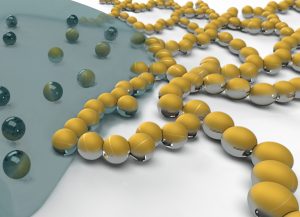 Shan Jiang, assistant professor of materials science and engineering, has led his research team to a pioneering discovery in Janus particles that could impact the research and development of surface coatings, cosmetics, 3-D printing, drug formulation and more.
Shan Jiang, assistant professor of materials science and engineering, has led his research team to a pioneering discovery in Janus particles that could impact the research and development of surface coatings, cosmetics, 3-D printing, drug formulation and more.
The resulting research article has been chosen as a back-cover feature in Soft Matter journal.
The publication is entitled “Drying medicated orientation and assembly structure of amphiphilic Janus particles,” but what does that mean in the advancement of technology?
According to Jiang, the research team made extremely small particles, about one-tenth of the thickness of a human hair, then made one side attracted to water while the other side is repelled by it. The dispersion of the particles in water creates a coating with no volatile solvent which can make an entire surface repel water.
“If we put this coating on a kitchen wall, it will be extremely easy to clean. If we coat this material on a tie, it may never get dirty. Our experiments and simulations revealed the reason why this new coating material could work,” Jiang said.
The results of the research have led the way to new initiatives to develop a “smart coating” system, which can create a self-cleaning surface, according to Jiang. There is also exploration into how the particles may interact with cells to help deliver drugs to treat diseases.
When Jiang and his team of two Ph.D. candidates, Kyle Miller and Ayuna Tsyrenova, initiated the project and began to lead the experimental side of the research, they weren’t expecting to make such a splash.
“In one of our electron microscope images, we noticed some interesting features. Then we designed experiments to study the phenomenon and collaborated with other groups to understand why it happened,” Jiang said.
The Iowa State team was joined in this effort by Stephen Anthony at Sandia National Laboratories, who helped with image analysis, and Xin Yong and Shiyi Qin at Binghamton University, who led the simulations.
“This publication is the combination of serendipity, persistence and collaboration,” Jiang said.
The research, according to Jiang, has important implications in many everyday products, and will pave the way to new ideas in coating materials and surface treatment. Additionally, the image analysis and computer simulation tools which were developed during this project could be implemented into other research topics.
To view the full research article, click here.
